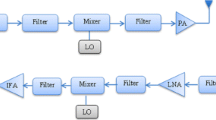Abstract
Energy consumption of Wireless Sensor Networks including On/Off keying (OOK) transmitter is important for short range transmission and long battery life time requirements. In order to improve the energy efficiency of an OOK transmitter, the Minimum Energy (ME) coding strategy is adopted in this paper. We first give the energy consumption model based on a real OOK transmitter, which has an energy efficiency of 52 pJ/bit by completely switching off the transmitter during the transmission of low bit ’0’. Based on this energy consumption model, ME-Coding provides an energy efficiency of 30 pJ/bit for coding size \(k=3\). Moreover, larger coding size offers more significant improvement, at the sacrifice of spectral efficiency and transmission range. In this paper, we have also determined a closed-form solution for the optimal coding size for a given transmission range constraint.










Similar content being viewed by others
References
Tekbyk, K., Rza Ekti, A., Kurt, G. K., & Görçin, A. (2019). Terahertz band communication systems: Challenges, novelties and standardization efforts. Physical Communication, 35, 10070.
Ulkar, M. G., Pusane, A. E., & Tugcu, T. (2019). Novel decoding methods of constant weight coding for molecular communications. Nano Communication Networks, 19, 157–167.
Yang, K., et al. (2020). A comprehensive survey on hybrid communication in context of molecular communication and terahertz communication for body-centric nanonetworks. IEEE Transactions on Molecular, Biological and Multi-Scale Communications, 6(2), 107–133.
Singh, R. K., Singh, S. P., & Pratap, S. (2020). Performance evaluation of Wireless nanosensor networks under interference. Nano Communication Networks, 25, 100–311.
Zainuddin, M. A., Dedu, E., & Bourgeois, J. (2016). Low-weight code comparison for electromagnetic wireless nanocommunication. IEEE Internet of Things Journal, 3(1), 38–48.
Huang, L., Yao, X., Wang, W., & Genshen, S. (2017). EOC: Energy optimization coding for wireless nanosensor networks in the terahertz band. IEEE Access, 5, 2583–2590.
Lin, Y. M., Dimitrakopoulos, C., Jenkins, K. A., Farmer, D. B., Chiu, H.-Y., Grill, A., & Avouris, Ph. (2010). 100-GHz transistors from wafer-scale epitaxial graphene. Science, 327(5966), 662.
Chi, Kaikai, Zhu, Yi.-hua, Jiang, Xiaohong, & Tian, Xian-zhong. (2013). Energy optimal coding for wireless nanosensor networks. IEEE Wireless Communications and Networking Conference (WCNC), 2013, 998–1002.
Jornet, J. M. (2014). Low-weight error-prevention codes for electromagnetic nanonetworks in the terahertz band. Nano Communication Networks, 5, 35–44.
Kocaoglu, M., & Akan, O. B. (2013). Minimum energy channel codes for nanoscale wireless communications. IEEE Transactions on Wireless Communications, 12, 1492–1500.
Huang, L., Wang, W., & Shen, S. (2016). Energy-efficient coding for electromagnetic nanonetworks in the terahertz band. Ad Hoc Networks, 40, 15–25.
Wang, A. Y., Cho, S. H., Sodini, C. G., & Chandrakasan, A. P. (2001). Energy efficient modulation and MAC for asymmetric RF microsensor systems. International Symposium on Low Power Electronics and Design, 1, 106–111.
Proakis, J. G. (2001). Digital Communications. New York, USA: McGraw-Hill.
Peng, Y., Andrieux, G., Diouris, J. F., & Diop, M. (2019). Energy optimization of an on-off keying (OOK) transmitter using high-order orthogonal modulation. International Journal of Electronics Letters, 7(2), 182–193.
Cook, B. W., Berny, A., Molnar, A., Lanzisera, S., & Pister, K. S. J. (2006). Low-power 2.4-GHz transceiver with passive RX front-end and 400-mV supply. IEEE Journal of Solid-State Circuits, 41(12), 2757–2766.
Daly, D. C., & Chandrakasan, A. P. (2007). An energy-efficient OOK transceiver for wireless sensor networks. IEEE Journal of Solid-State Circuits, 42(5), 1003–1011.
Chee, Y., Niknejad, A., & Rabaey, J. (2006). A 46% Efficient \(0.8\)dBm transmitter for wireless sensor networks. In 2006 Symposium on VLSI Circuits (pp. 43–44).
Kumarasamy Raja, M., et al. (2012). A 52 pJ/bit 433-MHz low power OOK transmitter. Analog Integrated Circuits and Signal Processing, 70, 57–67.
Erin, A. C., & Asada, H. H. (2001). Energy optimal point-to-point wireless data communications. IEEE International Conference on Communications, 8, 2410–2415.
Prakash, Y., & Gupta, S. K. S. (2003). Energy efficient source coding and modulation for wireless applications. Proceeding OF IEEE WCNC, 8, 212–217.
Jornet, J. M., & Akyildiz, I. F. (2012). Joint energy harvesting and communication analysis for perpetual wireless nanosensor networks in the terahertz band. IEEE Transactions on Nanotechnology, 11(3), 570–580.
Chi, K., Zhu, Y. H., Jiang, X., & Leung, V. C. (2014). Energy-efficient prefix-free codes for wireless nano-sensor networks using OOK modulation. IEEE Transactions on Wireless Communications, 13(5), 2670–2682.
Heinzelman, W. B., Chandrakasan, A. P., & Balakrishnan, H. (2002). An application-specific protocol architecture for wireless microsensor networks. IEEE Transactions on Wireless Communications, 1(4), 660–670.
Tang, Q., Gupta, S., & Schwiebert, L. (2005). Performance analysis of an on-off keying based minimum energy coding for energy constrained wireless sensor application. IEEE International Conference on Communications, 4(4), 2734–2738.
Peng, Y., Andrieux, G., & Diouris, J. -F. (2014). Realistic energy consumption model for on-off keying based minimum energy coding. In 2014 IEEE 79th vehicular technology conference (VTC Spring).
Acknowledgements
This work is partly supported by Shanghai Polytechnic University (Grant No. EGD21QD23).
Author information
Authors and Affiliations
Corresponding author
Ethics declarations
Conflict of interest
The authors declare that they have no conflict of interest.
Additional information
Publisher's Note
Springer Nature remains neutral with regard to jurisdictional claims in published maps and institutional affiliations.
Rights and permissions
About this article
Cite this article
Peng, Y., Andrieux, G. & Diouris, JF. Minimization of Energy Consumption for OOK Transmitter Through Minimum Energy Coding. Wireless Pers Commun 122, 2219–2233 (2022). https://doi.org/10.1007/s11277-021-08989-w
Accepted:
Published:
Issue Date:
DOI: https://doi.org/10.1007/s11277-021-08989-w




